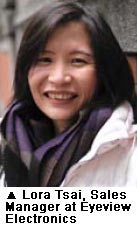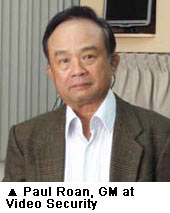Network dome cameras offer wide views and the connectivity of IP, forming a combination in global demand.
Network dome cameras offer wide views and the connectivity of IP, forming a combination in global demand.
With the growth of IP solutions, network dome cameras are a major part of new surveillance systems. Combining networked functions and a broader view, network domes provide more comprehensive security. Asia's versatile video providers offer a number of solutions suited for applications requiring effective surveillance.
Product Trends
Several network dome camera providers have experience with analog domes, making that expertise an advantage. "Eyeview has developed our own analog speed domes for more than five years," said Lora Tsai, Sales Manager at Eyeview Electronics. "For three and half years, based on our knowledge of speed dome cameras, we have implemented IP technology into our speed dome product line to offer the latest technology for IP speed dome camera solutions to the market."
Eyeview's understanding of speed domes is complemented by an IP background. "For IP speed dome cameras, the manufacturer not only needs good technology for offering stable and reliable speed dome cameras, but also must possess knowledge on IP networking," Tsai said. The company offers network domes with 530 TV line resolution, wide dynamic range and slow AE response for monitoring areas with abrupt lighting changes.
Some vendors have incorporated unique functions into their network domes, with Huviron's Power over Ethernet model featuring a megapixel progressive scan CCD, IR LEDs and a day/night filter exchange mechanism. "Users can get the best view of low-lux surveillance environments," said Lewis Oh, Sales Support, Huviron. "In addition, the camera successfully met the IP 67 criteria. This means that it is available for outdoor applications without any additional housing."
 Other network domes feature smarts. The VIVOTEK solution includes tamper detection, vandalproof housing and wide operating temperature range achieved a built-in fan and heater, said Owen Chen, Chairman of VIVOTEK.
Other network domes feature smarts. The VIVOTEK solution includes tamper detection, vandalproof housing and wide operating temperature range achieved a built-in fan and heater, said Owen Chen, Chairman of VIVOTEK.
Network functions enable remote surveillance, which is designed into some cameras. "The Video Security network dome uses an original speed dome with IP functions, allowing users to perform remote monitoring over the Internet," said Paul Roan, GM at Video Security. As part of remote monitoring, it supports alarm integration for video verification and has an API for remote manual recording.
A USB port allows operators to quickly locate each camera's IP address, along with allowing system upgrades, Roan said. Onboard storage in an SD card prevents the network from being overwhelmed, as users can choose which files they wish to view remotely and save costs for separate storage.
For optimized remote monitoring, Dynacolor's network dome solution offers dual  streaming in M-JPEG and MPEG-4. "The M-JPEG video streaming provides high-resolution image data and is suited for recording through local area networks (LAN), while we recommended switching to the more efficient MPEG-4 compression for remote Internet viewing," said Garrett Li, Marketing Specialist at Dynacolor.
streaming in M-JPEG and MPEG-4. "The M-JPEG video streaming provides high-resolution image data and is suited for recording through local area networks (LAN), while we recommended switching to the more efficient MPEG-4 compression for remote Internet viewing," said Garrett Li, Marketing Specialist at Dynacolor.
Its network domes come in two types fit for different applications, Li said. The vandal-proof dome is equipped with die-casting aluminum housing and PC dome cover and meet IP 66 standards. The mini fixed one, with anti-vibration design, fits in tight spaces, such as buses for mobile surveillance.
Regions
As networking becomes a worldwide phenomenon, network video is a growing trend. The largest uptake is seen in countries with a stable Internet infrastructure that can support the bandwidth network video devices require.
The West is a key target for Asian vendors. "The majority of our solutions are sold to Europe and American customers, with Japanese and Asian clients making up the rest," Roan said "There is worldwide demand for network cameras, as remote surveillance enables video to be viewed anytime, anywhere on computers or mobile devices."
Dynacolor's solutions are deployed globally, with the United Kingdom and Spain showing strong demand. "Due to security monitoring on public transportation, the demand for network mobile surveillance is increasing," Li said. Its solutions are offered by OEM and ODM to American distributors, who in turn provide them to local system integrators under their own brands.
The real-time video monitoring provided by network cameras depends on a reliable network. "Some countries currently do not have complete network systems, with too little bandwidth or unstable connections," Roan said. "This  affects the adoption of network cameras, which are largely deployed in countries with developed infrastructure, high bandwidth and stable networks."
affects the adoption of network cameras, which are largely deployed in countries with developed infrastructure, high bandwidth and stable networks."
Some emerging markets show promise. "Our products are mainly sold to Eastern Europe, South America and China, which we think have strong demand for IP solutions," Chen said.
Both mature and emerging markets have demand for network video. "Most of our IP speed domes are sold to countries in Europe, Asia and South America," Tsai said.
Verticals
Network cameras require a strong IP network for reliable transmission. As existing analog surveillance systems may not be able to support IP, network video is almost exclusively deployed in new video projects.
Eyeview's network video projects are deployed for city surveillance, power plants, police stations, casinos and copper mines. "Actually, we found that almost all the new government projects all over the world now are requesting IP solutions, like India," Tsai said.
A network's dome wide angle offers a better view of events. "A mini network dome is suited for applications with limited space, such as retail in convenience stores," Li said. Transportation, such as buses and trains, also has small spaces that mini network domes can squeeze into.
Large applications benefit from network video, with Dynacolor providing its solutions for transportation, residential (apartment communities) and gaming, Li said.
Recession Effects
The economic meltdown is already being felt by network dome providers. "The  current global financial crisis affects our business, because our major market is the United States," Oh said.
current global financial crisis affects our business, because our major market is the United States," Oh said.
Mature markets that relied on lending were hit hardest. "The global financial slowdown has affected our business, particularly in America, Europe and Japan," Chen said. "The exchange rate will have a short-term impact on our business, particularly in Japan."
Eyeview's business has been impacted by the economic downturn, so it plans on having more customer outreach to understand their needs. "For all costs, we must be very cautious," Tsai said. "Our sales force must work harder to keep close contact with our customers, in order to communicate more often with them. We will continue RD product development to offer the newest and most competitive technology products to our customers."
Dynacolor will continue on its course of offering leading technology. "We take great pride in our R&D and will not reduce our staff," Li said, with the company considering hiring new talent. "When the economy improves, we will able to offer products that are up to specification for our clients."
The company focuses on quality products, rather than competing in the entry level market. "We do not make our products to be the same as other ones, as we want to be above and beyond," Li said. "H.264 compression is now a basic requirement — we plan to offer more advanced features, such as built-in wide dynamic range, multimegapixel resolution and intelligent analysis functions."
Some vendors saw the economic downturn as an opportunity for more education. "While there are fewer camera orders due to the recession, we believe demand for network cameras will grow in the years to come," Roan said. "We will take this down time to train our employees about the differences between analog and network cameras, along with demonstrating to clients the convenience of network solutions."
For Video Security's domestic market of Taiwan, network video has not caught on, due to limited bandwidth and installers with no networking background. "This is the best time to turn a threat into an opportunity, by furthering employee training," Roan said. "Network cameras are not like analog cameras, which simply require cables to be strung — they require bandwidth and transmission settings to fulfill their full potential. Understanding the virtual world of the Internet is the only way to be competitive."
Challenges
Improving network domes will require several steps. Among them include an easier setup, rather than a time-consuming process. "In the future, network cameras will be able to support plug and play for the end user," Oh said.
Offering a cohesive solution is required for network video. "System integration, including the integration of optics, hardware and electronics into a single IP camera, will be necessary," Chen said. "Also, the integration of camera, peripherals and central management software into the service system will be important."
Troubleshooting issues, such as remotely viewing security video, must be addressed. "Image compression affects network transmission time, as it lags and has jerky video when done poorly," Roan said. "When many people are simultaneous viewing video remotely, it results in network overload, lost data and low image quality."
Video Security's network domes include circuits and infrared LEDs, while meeting IP 68 certification. "When chips begin processing images, they generate energy and can overheat, crashing operation," Roan said. "Effectively reducing heat from chips, or heat dissipation, is a developmental issue."
Some components do not deliver strong results, hurting the growth of network  video devices. "The traditional CMOS image sensors typically used in network cameras have unsatisfactory low-light performance," Li said. "Dynacolor deploys Sony CCDs and its new advanced CMOS sensors, which have improved light sensitivity, enabling network cameras to capture crucial moments."
video devices. "The traditional CMOS image sensors typically used in network cameras have unsatisfactory low-light performance," Li said. "Dynacolor deploys Sony CCDs and its new advanced CMOS sensors, which have improved light sensitivity, enabling network cameras to capture crucial moments."
Integration on a single platform requires network devices from different vendors to work together. "The third-party software on the market is very versatile," Tsai said. "How to integrate with most third-party software from the market is a big challenge for network camera manufacturers."